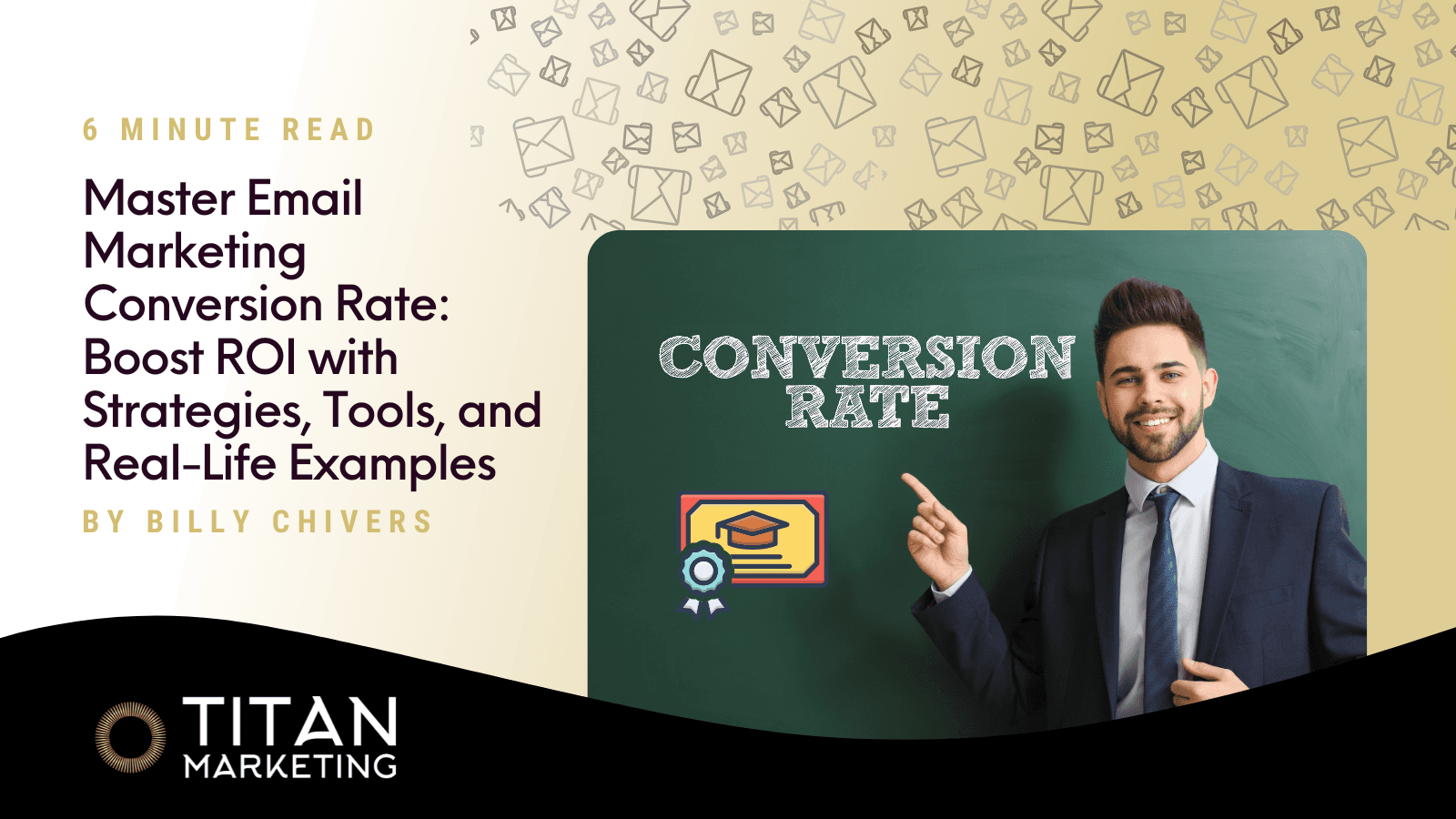
Blog
January 21, 2025

Blog
January 21, 2025

Blog
January 21, 2025
Unlock your email marketing's potential with actionable strategies and essential tools to boost conversion rates and ROI. Dive into our guide to transform your campaigns today!
Email marketing is a powerful tool for driving sales and engagement. But to truly succeed, you need to focus on one key metric: your email marketing conversion rate.
This blog will explain what this rate means, how to calculate it, and, most importantly, how to optimise it for better ROI. From actionable strategies to troubleshooting tips and real-world success stories, we’ll cover everything you need to transform your email campaigns.
Section 1: Understand What Email Marketing Conversion Rate Is and Why It Matters
What Is Email Marketing Conversion Rate?
The email marketing conversion rate measures the percentage of recipients who complete a specific desired action after opening your email. This action can vary depending on your campaign goals, such as:
Making a purchase.
Signing up for a webinar or event.
Downloading a resource, like an eBook or guide.
Filling out a form or survey.
It’s one of the most critical metrics in email marketing because it directly ties the performance of your emails to tangible business outcomes. If you're looking to compare the effectiveness of different email marketing platforms, you might find this guide on Klaviyo vs Mailchimp: Email & SMS Guide (2024) insightful.
Why It Matters
Understanding and improving your conversion rate is essential for the success of your email marketing strategy. Here’s why:
Measures Campaign Effectiveness
A high conversion rate indicates that your emails resonate with your audience, effectively persuading them to take action.
Conversely, a low conversion rate can signal issues with your email content, CTAs, or audience targeting.
Direct Impact on ROI
The better your conversion rate, the more revenue or leads you generate from the same email campaign.
For businesses relying heavily on email for sales or engagement, even small improvements in conversion rates can lead to significant revenue gains.
Identifies Areas for Optimisation
Tracking this metric highlights what works and what doesn’t, allowing you to refine your strategies.
Example
Imagine you’re running an email campaign to promote a new product. You send the email to 10,000 recipients, and based on the industry average conversion rate of 0.09%, only 9 people complete a purchase. However, if you optimise your campaign with stronger CTAs, better segmentation, and a compelling offer.
Section 2: Learn How to Calculate Email Marketing Conversion Rate
Step-by-Step Calculation

Example: If 200 people convert out of 10,000 delivered emails, your conversion rate is 2%.
Compare Your Conversion Rates to Industry Benchmarks
Campaign Email Conversion Rate Benchmarks
Understanding benchmarks helps you evaluate your campaign's success. Across industries, the typical conversion rate for email campaigns is just 0.09%, but top-performing campaigns can reach an impressive 0.47%.
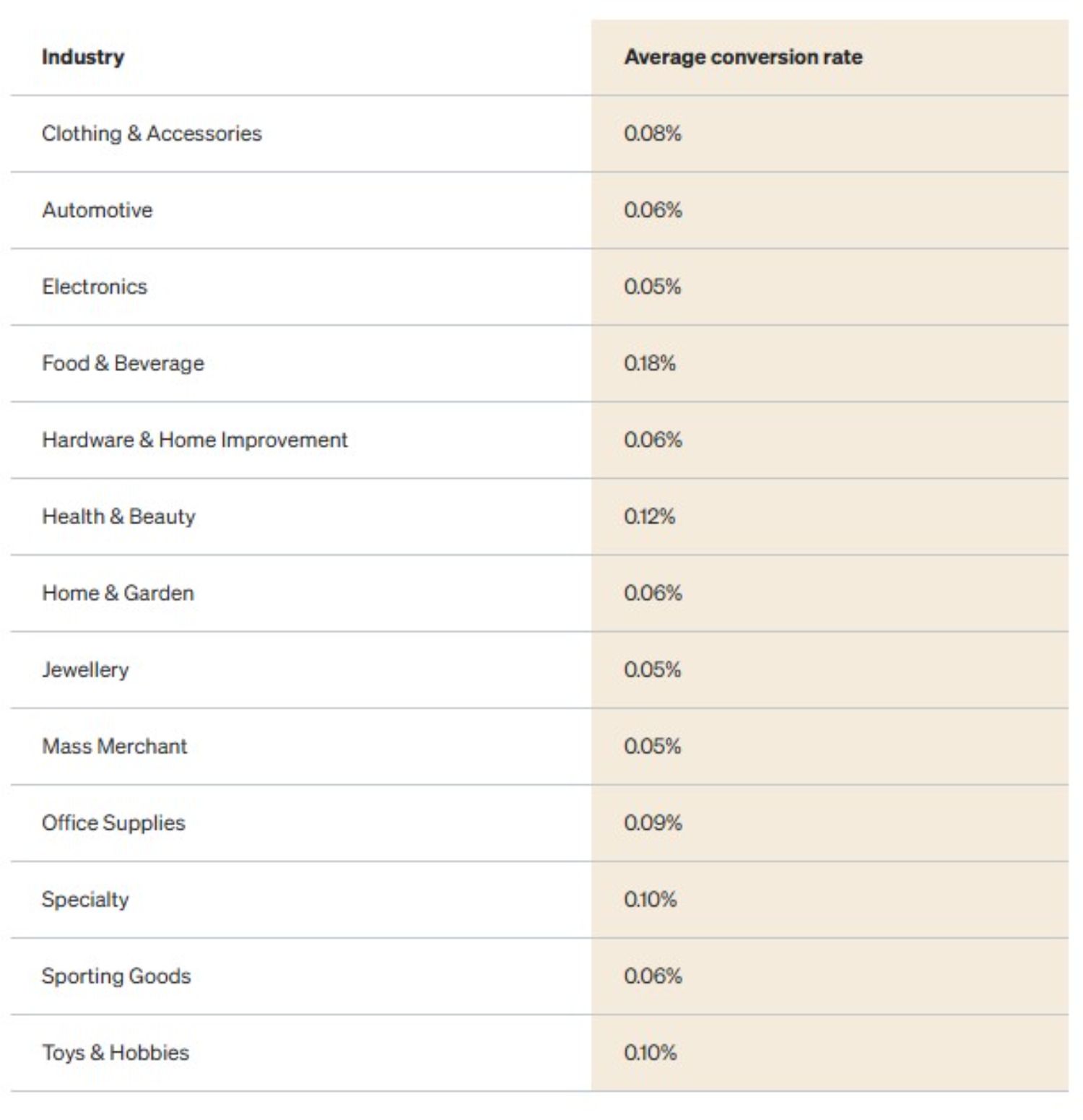
Source: Klaviyo
Automated Flows Email Conversion Rate Benchmarks
Automated email flows see an average open rate of 1.71% across industries, with top performers reaching an impressive 5.71%.
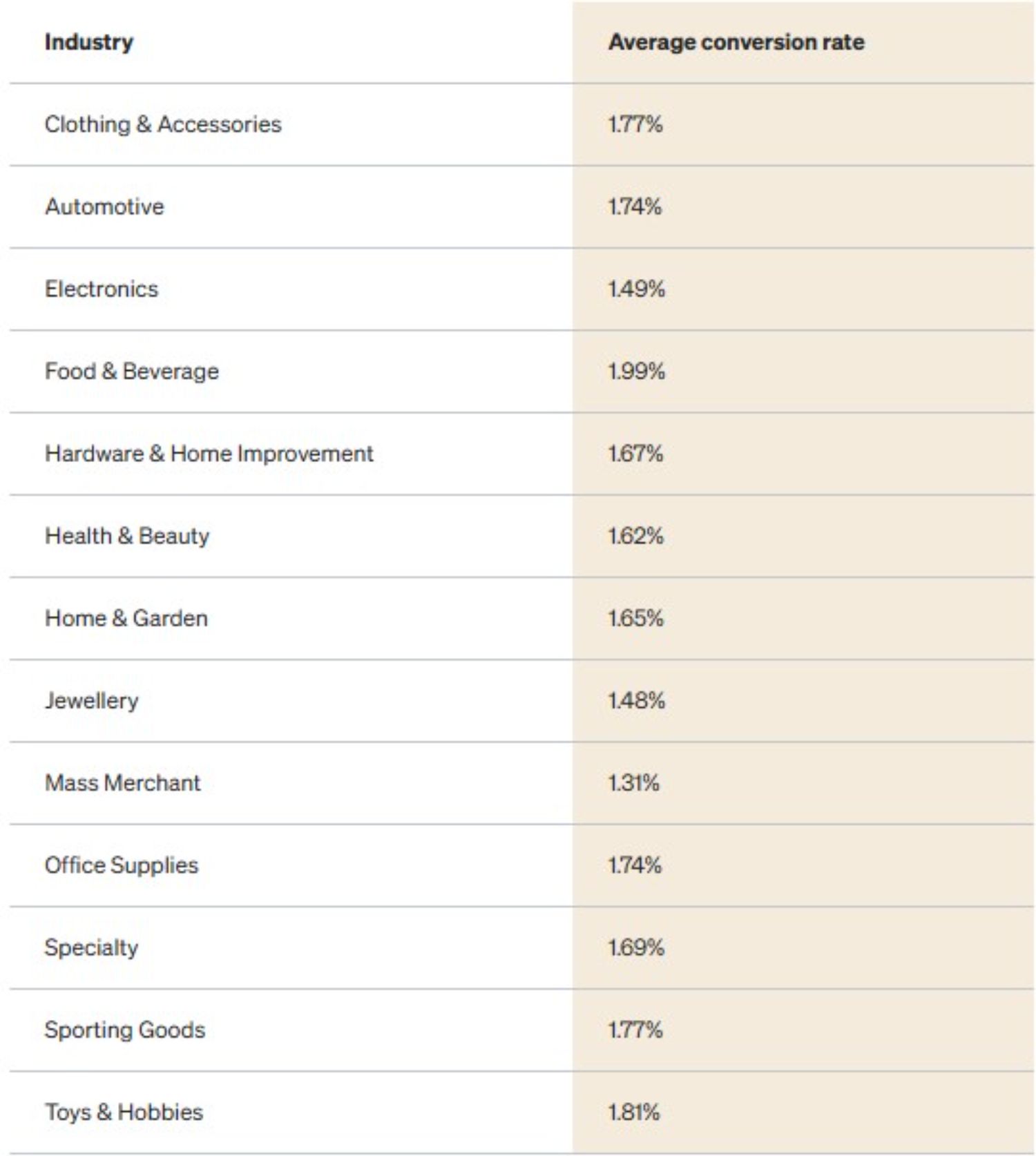
Source: Klaviyo
Section 3: Strategies to Supercharge Your Email Marketing Conversion Rates
Achieving a high email marketing conversion rate requires more than just sending emails, it’s about creating targeted, engaging, and action-driven campaigns.
1. Segment and Personalise Your Campaigns
Action Plan:
Divide your audience into meaningful segments based on demographics, behaviours, purchase history, or engagement levels.
Personalise email content to include dynamic elements like the recipient's name, location, or tailored product recommendations that match their interests or browsing history.
Why It Works:
Segmentation ensures your emails are relevant to each recipient, increasing the likelihood of engagement and conversion. Personalised campaigns deliver up to 6x higher transaction rates compared to generic emails.
If you're interested in exploring effective segmentation techniques, check out 3 Klaviyo Segmentation Strategies to Boost DTC Sales.
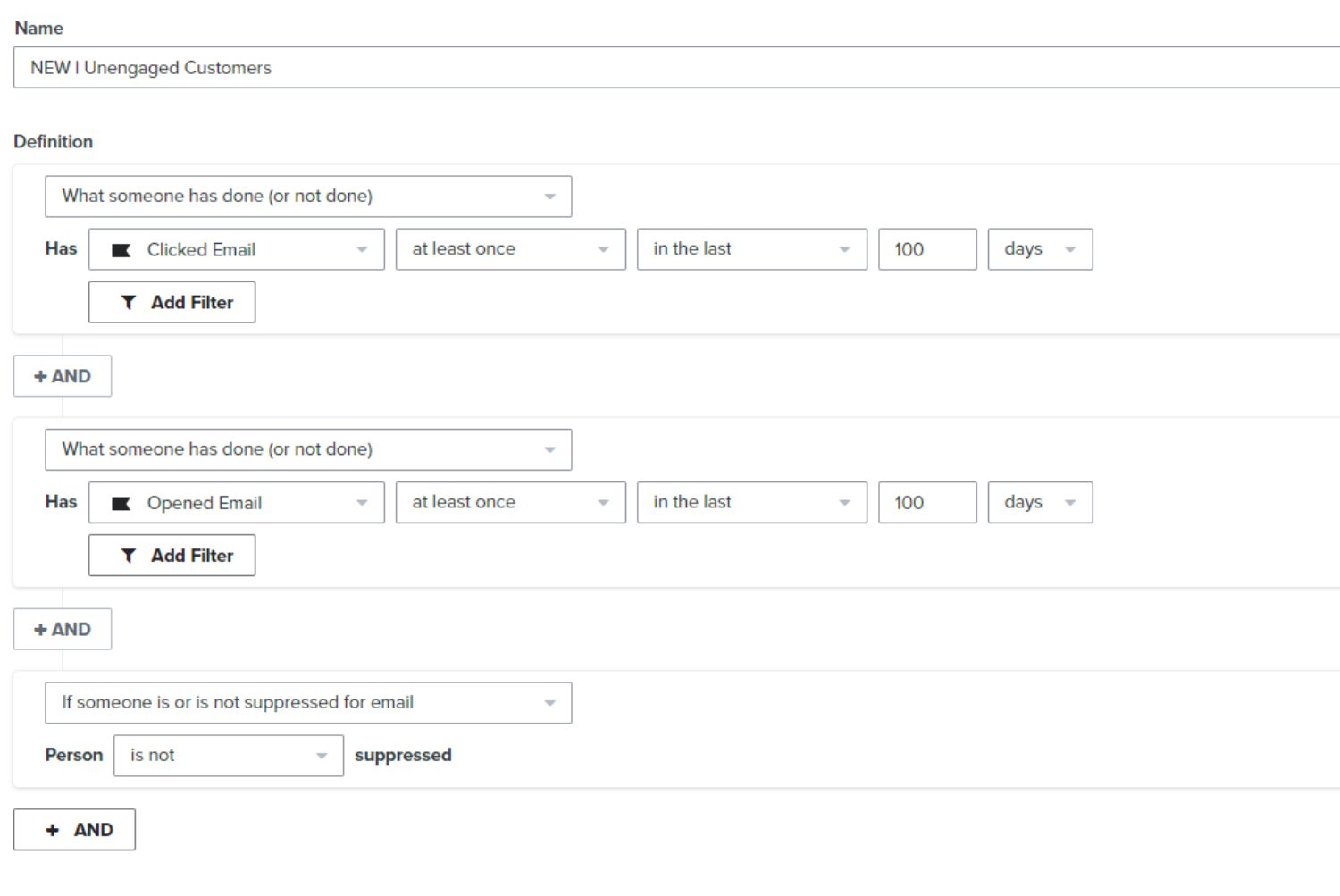
Source: Klaviyo

Source: Klaviyo
2. Create High-Impact Call-to-Actions (CTAs)
Action Plan:
Craft clear, compelling, and benefit-driven CTAs (e.g., “Claim Your Discount Now!” or “Discover Your Perfect Match”).
A/B test button designs, colours, and placements to determine what drives the most clicks.
Why It Works:
Strong CTAs guide recipients toward the desired action, creating a sense of urgency and clarity about what they need to do next.
For more insights on optimizing your emails, you might find 10 Essential A/B Tests to Boost Email Conversions valuable.
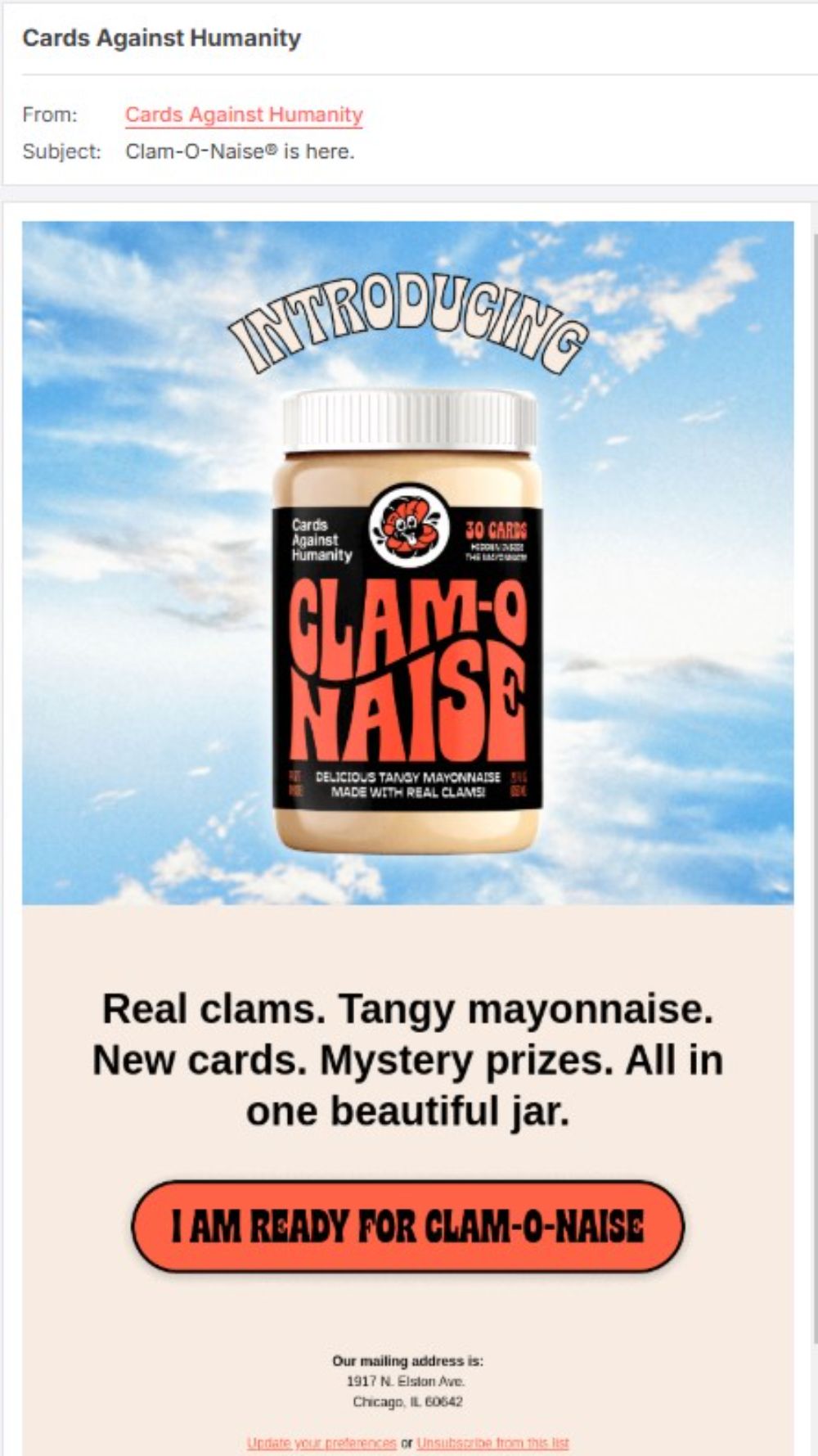
Source: ReallyGoodEmails
3. Test and Learn with A/B Testing
Action Plan:
Experiment with subject lines, visuals, CTAs, email content, and send times.
Analyse the performance of each variation to identify what resonates most with your audience.
Why It Works:
A/B testing takes the guesswork out of optimisation. By relying on data, you can make informed decisions to improve future campaigns.
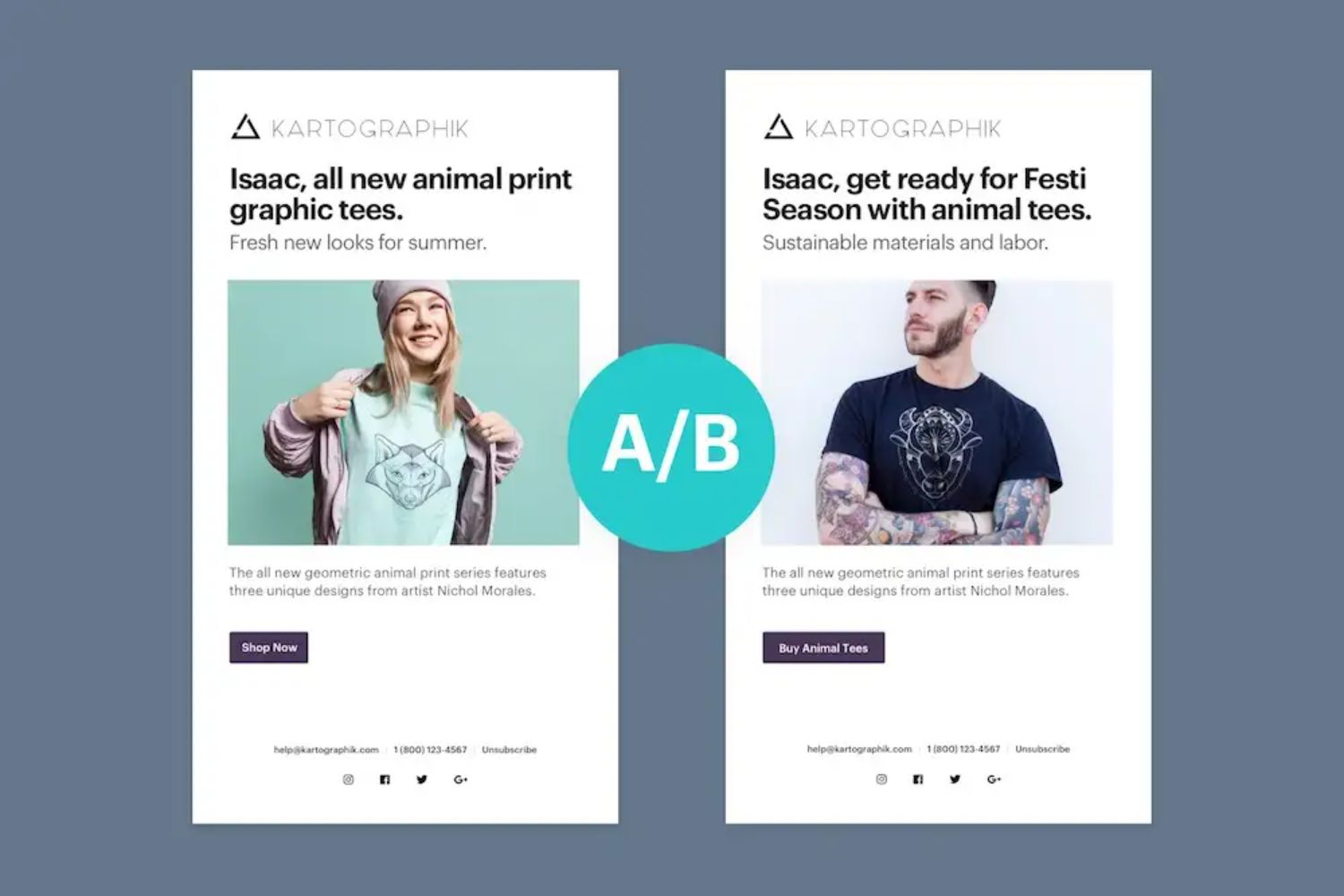
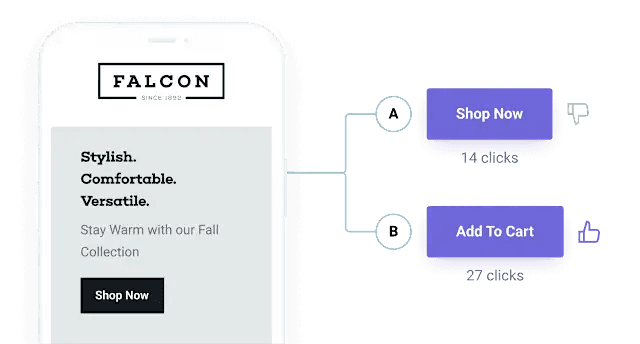
Source: Mailjet
4. Optimise for Mobile Devices
Action Plan:
Use responsive email designs that adapt to various screen sizes.
Keep copy concise and ensure buttons are easy to tap on small screens.
Why It Works:
Over 60% of emails are opened on mobile devices. If your emails aren’t mobile-friendly, you risk losing a significant portion of your audience.
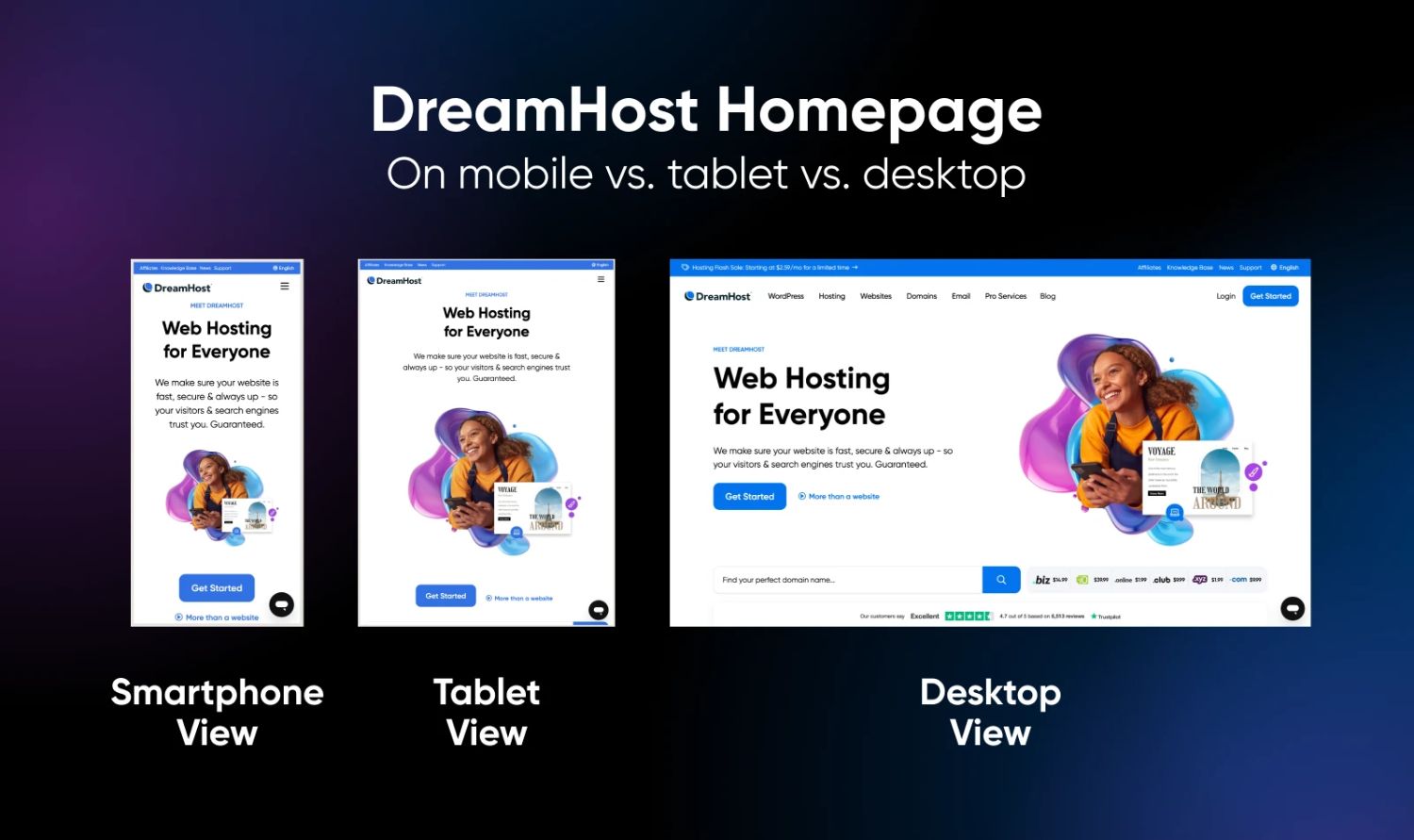
Source: DreamHost
5. Use Emotional Triggers in Copywriting
Action Plan:
Create a sense of urgency with phrases like “Limited Time Offer!” or “Ends Tonight!”
Build trust with social proof, such as customer testimonials or reviews.
Why It Works:
Emotional triggers tap into the audience's instincts and create a stronger motivation to act. Urgency encourages immediate action, while social proof builds confidence.

Source: Really Good Emails
6. Enhance Email Deliverability
Action Plan:
Regularly clean your email list by removing inactive or invalid addresses to reduce bounce rates.
Use a double opt-in process to confirm new subscribers and ensure the quality of your list.
If you're struggling with email deliverability issues, you can refer to our Email Deliverability: Step-by-Step Checklist to Stay Out of Spam.
Why It Works:
High deliverability rates mean more emails land in inboxes, increasing the chances of conversion. Poor deliverability not only reduces engagement but also harms your sender reputation.
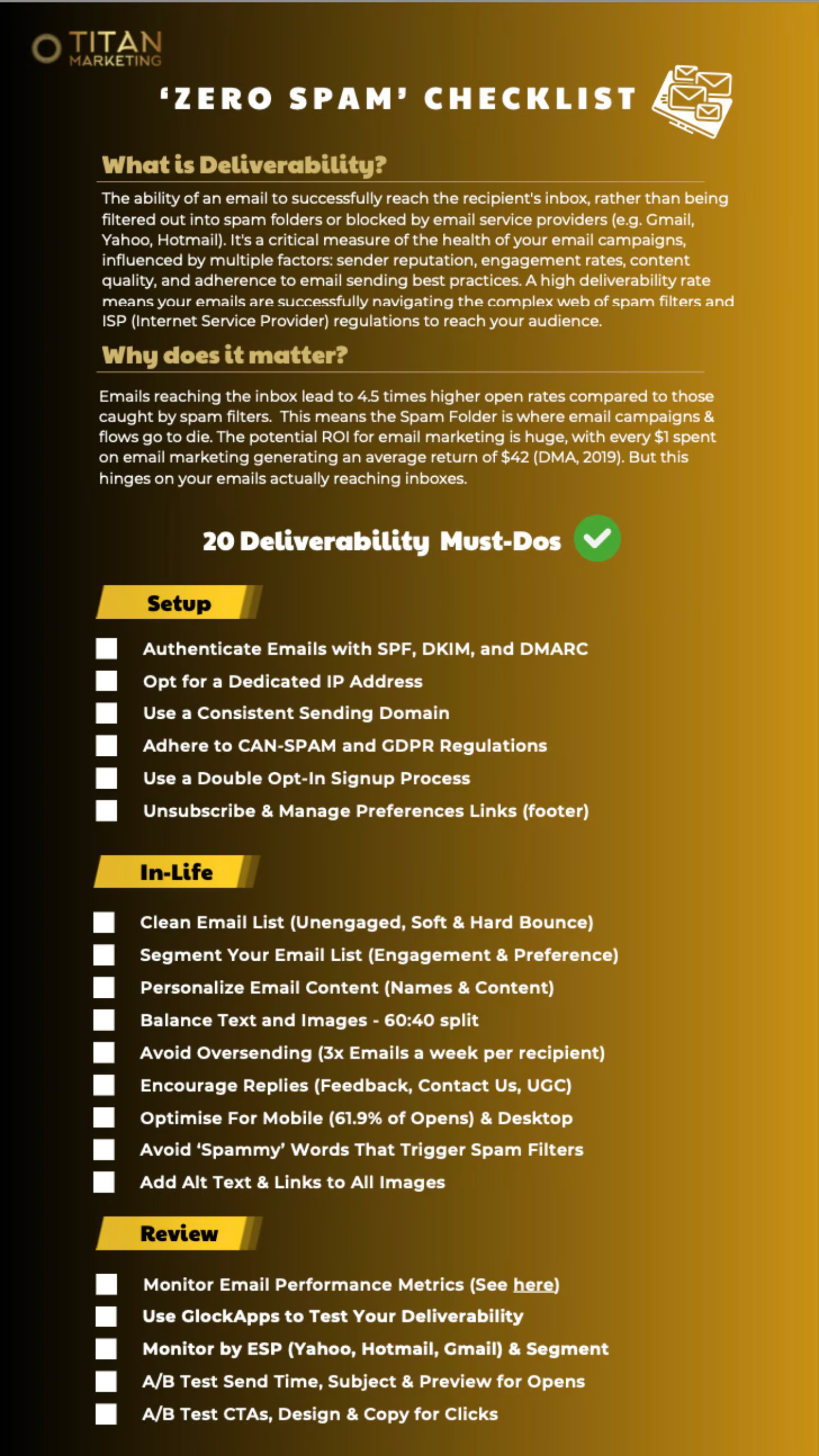
7. Leverage Automated Email Sequences
Action Plan:
Set up automated workflows such as welcome series, abandoned cart reminders, and post-purchase follow-ups.
Ensure the timing and content of these emails are relevant and personalised to the recipient's journey.
Why It Works:
Automation keeps your audience engaged without requiring constant manual effort, nurturing them through the sales funnel and boosting conversions.
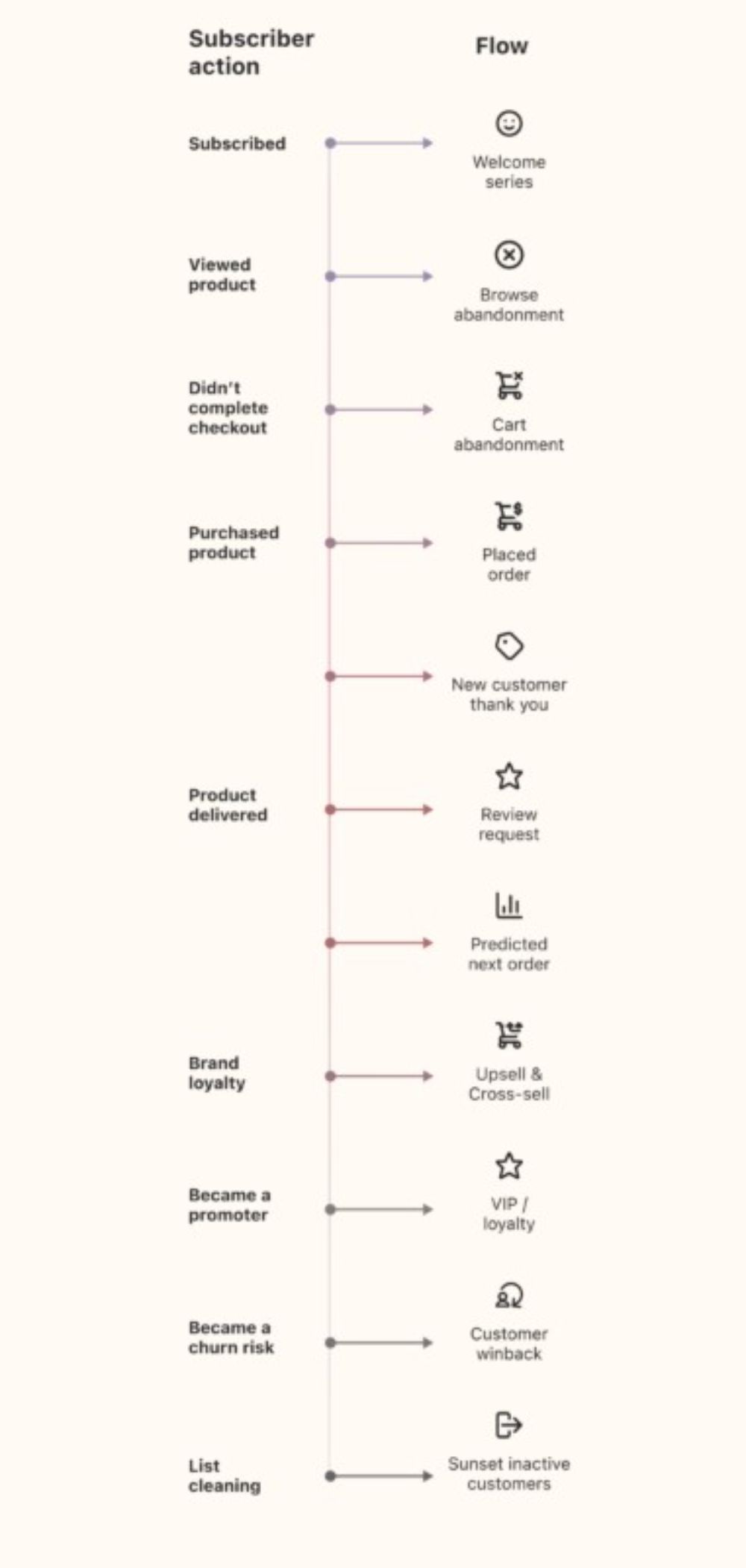
Source: Klaviyo
8. Innovate Your Offer to Maximise Conversions
Action Plan:
Stop relying on the same old discounts like "10% off" to bring customers back. Instead, innovate and test fresh, creative offers. Here are a few ideas:
Cashback Offers: Use tools like Fondue, which can reduce costs by up to 70% compared to traditional percentage-off discounts, offering a win-win for both you and your customers.
Gift with Purchase: Reward customers with a thoughtful bonus item when they complete their purchase.
Loyalty Incentives: Encourage sign-ups for loyalty programmes by offering extra points or exclusive perks upon purchase.
Why It Works:
Sometimes, it’s not the follow-up email but the offer that makes all the difference. Testing innovative offers keeps your campaigns fresh and allows you to discover what truly resonates with your audience. A well-crafted incentive can significantly boost conversions without heavily impacting your margins.

Section 4: Troubleshooting Low Email Conversion Rates
Identify and fix common pitfalls that might be lowering your email conversion rates with these practical solutions.

Section 5: Adapt Strategies for Seasonal Campaigns
Leverage High-Conversion Opportunities During Holidays
1. Create Urgency with Seasonal CTAs:
Use phrases like “Limited Time Black Friday Deals” or “Cyber Monday Flash Sale.”
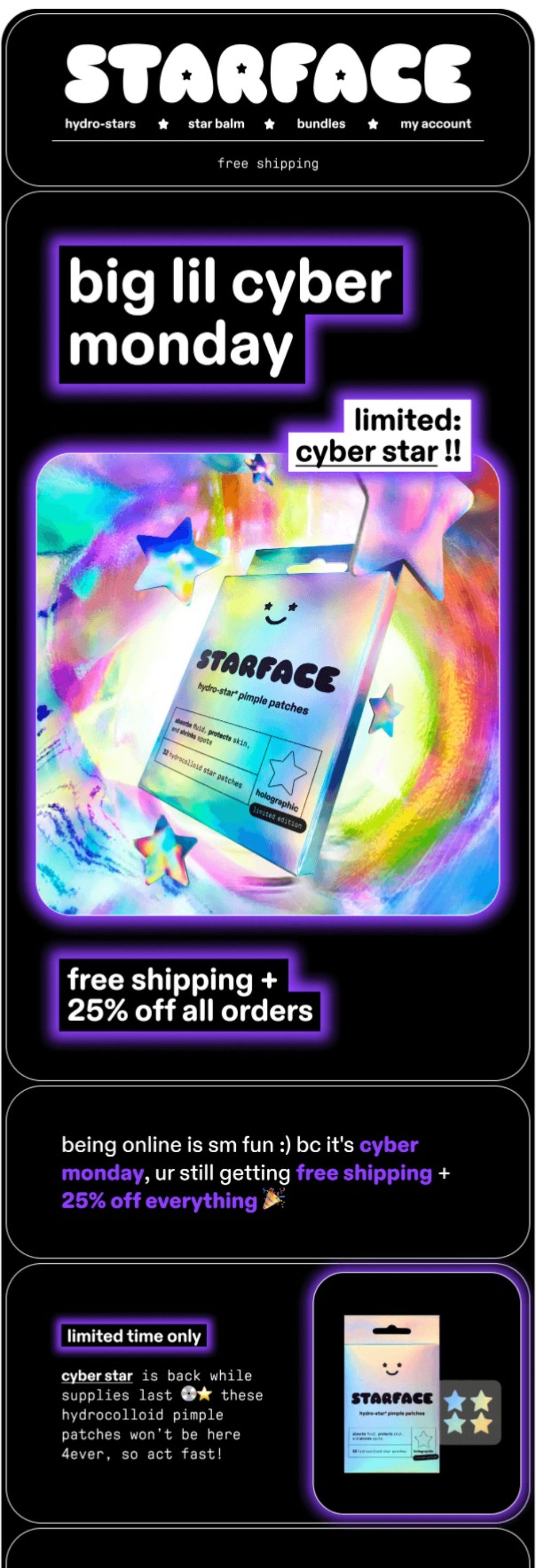
2. Highlight Holiday-Specific Products:
Showcase products that are popular during specific holidays or seasons.
For more tips on preparing for high-impact seasonal campaigns, you can refer to Mastering BFCM: The Ultimate Guide (2024).

Keep Engagement Strong During Off-Seasons
1. Offer Loyalty Rewards:
Reward your loyal customers with exclusive discounts or early access to sales.

2. Exclusive Discounts:
Provide discounts that are only available to your email subscribers.

3. Retarget Inactive Users:
Re-engage inactive users with personalised offers or reminders.
Example: “We miss you! Here’s 15% off your next order—come back and see what’s new!” Include recommendations based on their previous purchases.
Source (All Examples): Really Good Emails
Section 7: Use These Tools to Track and Optimise Performance
Recommended Tools for Email Marketing
Klaviyo: Provides advanced segmentation and detailed analytics for targeted campaigns.
Mailchimp: Offers user-friendly dashboards that simplify campaign monitoring and management.
Google Analytics: Tracks email-driven website actions, providing insights into user behaviour and campaign effectiveness.
Key Metrics to Monitor
Open Rates: Measure the effectiveness of your subject lines. High open rates indicate that your subject line was compelling enough to get recipients to open the email. For more strategies, check out 8 Proven Strategies to Boost Your Open Rates.
Click-Through Rates (CTR): Track how engaging your email content is. A high CTR means your audience is finding your content interesting and valuable. For more detailed strategies to boost your CTR, check out 15 Actionable Strategies to Improve Click-Through Rate: A Comprehensive Guide.
Conversion Rates: Assess the overall success of your campaign by measuring how many recipients completed the desired action, such as making a purchase or signing up for a newsletter.
Conclusion
To get the most out of your email marketing, you need to know how well your emails make people take action. This is called the conversion rate. By sending emails that match what different groups of people like, you can get more of them to do what you want. Testing different parts of your emails and using emotional language can help make your emails better.
Keeping an eye on key numbers, like how many people open your emails and click on links, helps you improve your emails over time. Fixing common problems like unclear buttons and boring content can help make your email efforts successful. By doing all these things, your emails can lead to more sales and business growth.
Key Takeaways
Understand What Email Marketing Conversion Rate Is and Why It Matters: Grasping this metric is crucial for measuring your campaign's success and driving business outcomes.
Use Segmentation and Personalisation: Tailor your emails to specific audience segments to increase engagement and conversion rates.
Leverage A/B Testing and Emotional Triggers: Optimize your campaigns by testing different elements and using emotional triggers to prompt action.
Monitor Performance Metrics: Continuously track key metrics to identify areas for improvement and refine your strategies.
Struggling with Low Email Conversions? Get Expert Tips Now!
Don’t let poor performance hold back your campaigns. Click here to schedule a free audit with us and uncover actionable strategies to boost order rate!
Email marketing is a powerful tool for driving sales and engagement. But to truly succeed, you need to focus on one key metric: your email marketing conversion rate.
This blog will explain what this rate means, how to calculate it, and, most importantly, how to optimise it for better ROI. From actionable strategies to troubleshooting tips and real-world success stories, we’ll cover everything you need to transform your email campaigns.
Section 1: Understand What Email Marketing Conversion Rate Is and Why It Matters
What Is Email Marketing Conversion Rate?
The email marketing conversion rate measures the percentage of recipients who complete a specific desired action after opening your email. This action can vary depending on your campaign goals, such as:
Making a purchase.
Signing up for a webinar or event.
Downloading a resource, like an eBook or guide.
Filling out a form or survey.
It’s one of the most critical metrics in email marketing because it directly ties the performance of your emails to tangible business outcomes. If you're looking to compare the effectiveness of different email marketing platforms, you might find this guide on Klaviyo vs Mailchimp: Email & SMS Guide (2024) insightful.
Why It Matters
Understanding and improving your conversion rate is essential for the success of your email marketing strategy. Here’s why:
Measures Campaign Effectiveness
A high conversion rate indicates that your emails resonate with your audience, effectively persuading them to take action.
Conversely, a low conversion rate can signal issues with your email content, CTAs, or audience targeting.
Direct Impact on ROI
The better your conversion rate, the more revenue or leads you generate from the same email campaign.
For businesses relying heavily on email for sales or engagement, even small improvements in conversion rates can lead to significant revenue gains.
Identifies Areas for Optimisation
Tracking this metric highlights what works and what doesn’t, allowing you to refine your strategies.
Example
Imagine you’re running an email campaign to promote a new product. You send the email to 10,000 recipients, and based on the industry average conversion rate of 0.09%, only 9 people complete a purchase. However, if you optimise your campaign with stronger CTAs, better segmentation, and a compelling offer.
Section 2: Learn How to Calculate Email Marketing Conversion Rate
Step-by-Step Calculation

Example: If 200 people convert out of 10,000 delivered emails, your conversion rate is 2%.
Compare Your Conversion Rates to Industry Benchmarks
Campaign Email Conversion Rate Benchmarks
Understanding benchmarks helps you evaluate your campaign's success. Across industries, the typical conversion rate for email campaigns is just 0.09%, but top-performing campaigns can reach an impressive 0.47%.

Source: Klaviyo
Automated Flows Email Conversion Rate Benchmarks
Automated email flows see an average open rate of 1.71% across industries, with top performers reaching an impressive 5.71%.

Source: Klaviyo
Section 3: Strategies to Supercharge Your Email Marketing Conversion Rates
Achieving a high email marketing conversion rate requires more than just sending emails, it’s about creating targeted, engaging, and action-driven campaigns.
1. Segment and Personalise Your Campaigns
Action Plan:
Divide your audience into meaningful segments based on demographics, behaviours, purchase history, or engagement levels.
Personalise email content to include dynamic elements like the recipient's name, location, or tailored product recommendations that match their interests or browsing history.
Why It Works:
Segmentation ensures your emails are relevant to each recipient, increasing the likelihood of engagement and conversion. Personalised campaigns deliver up to 6x higher transaction rates compared to generic emails.
If you're interested in exploring effective segmentation techniques, check out 3 Klaviyo Segmentation Strategies to Boost DTC Sales.

Source: Klaviyo

Source: Klaviyo
2. Create High-Impact Call-to-Actions (CTAs)
Action Plan:
Craft clear, compelling, and benefit-driven CTAs (e.g., “Claim Your Discount Now!” or “Discover Your Perfect Match”).
A/B test button designs, colours, and placements to determine what drives the most clicks.
Why It Works:
Strong CTAs guide recipients toward the desired action, creating a sense of urgency and clarity about what they need to do next.
For more insights on optimizing your emails, you might find 10 Essential A/B Tests to Boost Email Conversions valuable.

Source: ReallyGoodEmails
3. Test and Learn with A/B Testing
Action Plan:
Experiment with subject lines, visuals, CTAs, email content, and send times.
Analyse the performance of each variation to identify what resonates most with your audience.
Why It Works:
A/B testing takes the guesswork out of optimisation. By relying on data, you can make informed decisions to improve future campaigns.


Source: Mailjet
4. Optimise for Mobile Devices
Action Plan:
Use responsive email designs that adapt to various screen sizes.
Keep copy concise and ensure buttons are easy to tap on small screens.
Why It Works:
Over 60% of emails are opened on mobile devices. If your emails aren’t mobile-friendly, you risk losing a significant portion of your audience.

Source: DreamHost
5. Use Emotional Triggers in Copywriting
Action Plan:
Create a sense of urgency with phrases like “Limited Time Offer!” or “Ends Tonight!”
Build trust with social proof, such as customer testimonials or reviews.
Why It Works:
Emotional triggers tap into the audience's instincts and create a stronger motivation to act. Urgency encourages immediate action, while social proof builds confidence.

Source: Really Good Emails
6. Enhance Email Deliverability
Action Plan:
Regularly clean your email list by removing inactive or invalid addresses to reduce bounce rates.
Use a double opt-in process to confirm new subscribers and ensure the quality of your list.
If you're struggling with email deliverability issues, you can refer to our Email Deliverability: Step-by-Step Checklist to Stay Out of Spam.
Why It Works:
High deliverability rates mean more emails land in inboxes, increasing the chances of conversion. Poor deliverability not only reduces engagement but also harms your sender reputation.

7. Leverage Automated Email Sequences
Action Plan:
Set up automated workflows such as welcome series, abandoned cart reminders, and post-purchase follow-ups.
Ensure the timing and content of these emails are relevant and personalised to the recipient's journey.
Why It Works:
Automation keeps your audience engaged without requiring constant manual effort, nurturing them through the sales funnel and boosting conversions.

Source: Klaviyo
8. Innovate Your Offer to Maximise Conversions
Action Plan:
Stop relying on the same old discounts like "10% off" to bring customers back. Instead, innovate and test fresh, creative offers. Here are a few ideas:
Cashback Offers: Use tools like Fondue, which can reduce costs by up to 70% compared to traditional percentage-off discounts, offering a win-win for both you and your customers.
Gift with Purchase: Reward customers with a thoughtful bonus item when they complete their purchase.
Loyalty Incentives: Encourage sign-ups for loyalty programmes by offering extra points or exclusive perks upon purchase.
Why It Works:
Sometimes, it’s not the follow-up email but the offer that makes all the difference. Testing innovative offers keeps your campaigns fresh and allows you to discover what truly resonates with your audience. A well-crafted incentive can significantly boost conversions without heavily impacting your margins.

Section 4: Troubleshooting Low Email Conversion Rates
Identify and fix common pitfalls that might be lowering your email conversion rates with these practical solutions.

Section 5: Adapt Strategies for Seasonal Campaigns
Leverage High-Conversion Opportunities During Holidays
1. Create Urgency with Seasonal CTAs:
Use phrases like “Limited Time Black Friday Deals” or “Cyber Monday Flash Sale.”

2. Highlight Holiday-Specific Products:
Showcase products that are popular during specific holidays or seasons.
For more tips on preparing for high-impact seasonal campaigns, you can refer to Mastering BFCM: The Ultimate Guide (2024).

Keep Engagement Strong During Off-Seasons
1. Offer Loyalty Rewards:
Reward your loyal customers with exclusive discounts or early access to sales.

2. Exclusive Discounts:
Provide discounts that are only available to your email subscribers.

3. Retarget Inactive Users:
Re-engage inactive users with personalised offers or reminders.
Example: “We miss you! Here’s 15% off your next order—come back and see what’s new!” Include recommendations based on their previous purchases.
Source (All Examples): Really Good Emails
Section 7: Use These Tools to Track and Optimise Performance
Recommended Tools for Email Marketing
Klaviyo: Provides advanced segmentation and detailed analytics for targeted campaigns.
Mailchimp: Offers user-friendly dashboards that simplify campaign monitoring and management.
Google Analytics: Tracks email-driven website actions, providing insights into user behaviour and campaign effectiveness.
Key Metrics to Monitor
Open Rates: Measure the effectiveness of your subject lines. High open rates indicate that your subject line was compelling enough to get recipients to open the email. For more strategies, check out 8 Proven Strategies to Boost Your Open Rates.
Click-Through Rates (CTR): Track how engaging your email content is. A high CTR means your audience is finding your content interesting and valuable. For more detailed strategies to boost your CTR, check out 15 Actionable Strategies to Improve Click-Through Rate: A Comprehensive Guide.
Conversion Rates: Assess the overall success of your campaign by measuring how many recipients completed the desired action, such as making a purchase or signing up for a newsletter.
Conclusion
To get the most out of your email marketing, you need to know how well your emails make people take action. This is called the conversion rate. By sending emails that match what different groups of people like, you can get more of them to do what you want. Testing different parts of your emails and using emotional language can help make your emails better.
Keeping an eye on key numbers, like how many people open your emails and click on links, helps you improve your emails over time. Fixing common problems like unclear buttons and boring content can help make your email efforts successful. By doing all these things, your emails can lead to more sales and business growth.
Key Takeaways
Understand What Email Marketing Conversion Rate Is and Why It Matters: Grasping this metric is crucial for measuring your campaign's success and driving business outcomes.
Use Segmentation and Personalisation: Tailor your emails to specific audience segments to increase engagement and conversion rates.
Leverage A/B Testing and Emotional Triggers: Optimize your campaigns by testing different elements and using emotional triggers to prompt action.
Monitor Performance Metrics: Continuously track key metrics to identify areas for improvement and refine your strategies.
Struggling with Low Email Conversions? Get Expert Tips Now!
Don’t let poor performance hold back your campaigns. Click here to schedule a free audit with us and uncover actionable strategies to boost order rate!
Unlock your email marketing's potential with actionable strategies and essential tools to boost conversion rates and ROI. Dive into our guide to transform your campaigns today!
Email marketing is a powerful tool for driving sales and engagement. But to truly succeed, you need to focus on one key metric: your email marketing conversion rate.
This blog will explain what this rate means, how to calculate it, and, most importantly, how to optimise it for better ROI. From actionable strategies to troubleshooting tips and real-world success stories, we’ll cover everything you need to transform your email campaigns.
Section 1: Understand What Email Marketing Conversion Rate Is and Why It Matters
What Is Email Marketing Conversion Rate?
The email marketing conversion rate measures the percentage of recipients who complete a specific desired action after opening your email. This action can vary depending on your campaign goals, such as:
Making a purchase.
Signing up for a webinar or event.
Downloading a resource, like an eBook or guide.
Filling out a form or survey.
It’s one of the most critical metrics in email marketing because it directly ties the performance of your emails to tangible business outcomes. If you're looking to compare the effectiveness of different email marketing platforms, you might find this guide on Klaviyo vs Mailchimp: Email & SMS Guide (2024) insightful.
Why It Matters
Understanding and improving your conversion rate is essential for the success of your email marketing strategy. Here’s why:
Measures Campaign Effectiveness
A high conversion rate indicates that your emails resonate with your audience, effectively persuading them to take action.
Conversely, a low conversion rate can signal issues with your email content, CTAs, or audience targeting.
Direct Impact on ROI
The better your conversion rate, the more revenue or leads you generate from the same email campaign.
For businesses relying heavily on email for sales or engagement, even small improvements in conversion rates can lead to significant revenue gains.
Identifies Areas for Optimisation
Tracking this metric highlights what works and what doesn’t, allowing you to refine your strategies.
Example
Imagine you’re running an email campaign to promote a new product. You send the email to 10,000 recipients, and based on the industry average conversion rate of 0.09%, only 9 people complete a purchase. However, if you optimise your campaign with stronger CTAs, better segmentation, and a compelling offer.
Section 2: Learn How to Calculate Email Marketing Conversion Rate
Step-by-Step Calculation

Example: If 200 people convert out of 10,000 delivered emails, your conversion rate is 2%.
Compare Your Conversion Rates to Industry Benchmarks
Campaign Email Conversion Rate Benchmarks
Understanding benchmarks helps you evaluate your campaign's success. Across industries, the typical conversion rate for email campaigns is just 0.09%, but top-performing campaigns can reach an impressive 0.47%.

Source: Klaviyo
Automated Flows Email Conversion Rate Benchmarks
Automated email flows see an average open rate of 1.71% across industries, with top performers reaching an impressive 5.71%.

Source: Klaviyo
Section 3: Strategies to Supercharge Your Email Marketing Conversion Rates
Achieving a high email marketing conversion rate requires more than just sending emails, it’s about creating targeted, engaging, and action-driven campaigns.
1. Segment and Personalise Your Campaigns
Action Plan:
Divide your audience into meaningful segments based on demographics, behaviours, purchase history, or engagement levels.
Personalise email content to include dynamic elements like the recipient's name, location, or tailored product recommendations that match their interests or browsing history.
Why It Works:
Segmentation ensures your emails are relevant to each recipient, increasing the likelihood of engagement and conversion. Personalised campaigns deliver up to 6x higher transaction rates compared to generic emails.
If you're interested in exploring effective segmentation techniques, check out 3 Klaviyo Segmentation Strategies to Boost DTC Sales.

Source: Klaviyo

Source: Klaviyo
2. Create High-Impact Call-to-Actions (CTAs)
Action Plan:
Craft clear, compelling, and benefit-driven CTAs (e.g., “Claim Your Discount Now!” or “Discover Your Perfect Match”).
A/B test button designs, colours, and placements to determine what drives the most clicks.
Why It Works:
Strong CTAs guide recipients toward the desired action, creating a sense of urgency and clarity about what they need to do next.
For more insights on optimizing your emails, you might find 10 Essential A/B Tests to Boost Email Conversions valuable.

Source: ReallyGoodEmails
3. Test and Learn with A/B Testing
Action Plan:
Experiment with subject lines, visuals, CTAs, email content, and send times.
Analyse the performance of each variation to identify what resonates most with your audience.
Why It Works:
A/B testing takes the guesswork out of optimisation. By relying on data, you can make informed decisions to improve future campaigns.


Source: Mailjet
4. Optimise for Mobile Devices
Action Plan:
Use responsive email designs that adapt to various screen sizes.
Keep copy concise and ensure buttons are easy to tap on small screens.
Why It Works:
Over 60% of emails are opened on mobile devices. If your emails aren’t mobile-friendly, you risk losing a significant portion of your audience.

Source: DreamHost
5. Use Emotional Triggers in Copywriting
Action Plan:
Create a sense of urgency with phrases like “Limited Time Offer!” or “Ends Tonight!”
Build trust with social proof, such as customer testimonials or reviews.
Why It Works:
Emotional triggers tap into the audience's instincts and create a stronger motivation to act. Urgency encourages immediate action, while social proof builds confidence.

Source: Really Good Emails
6. Enhance Email Deliverability
Action Plan:
Regularly clean your email list by removing inactive or invalid addresses to reduce bounce rates.
Use a double opt-in process to confirm new subscribers and ensure the quality of your list.
If you're struggling with email deliverability issues, you can refer to our Email Deliverability: Step-by-Step Checklist to Stay Out of Spam.
Why It Works:
High deliverability rates mean more emails land in inboxes, increasing the chances of conversion. Poor deliverability not only reduces engagement but also harms your sender reputation.

7. Leverage Automated Email Sequences
Action Plan:
Set up automated workflows such as welcome series, abandoned cart reminders, and post-purchase follow-ups.
Ensure the timing and content of these emails are relevant and personalised to the recipient's journey.
Why It Works:
Automation keeps your audience engaged without requiring constant manual effort, nurturing them through the sales funnel and boosting conversions.

Source: Klaviyo
8. Innovate Your Offer to Maximise Conversions
Action Plan:
Stop relying on the same old discounts like "10% off" to bring customers back. Instead, innovate and test fresh, creative offers. Here are a few ideas:
Cashback Offers: Use tools like Fondue, which can reduce costs by up to 70% compared to traditional percentage-off discounts, offering a win-win for both you and your customers.
Gift with Purchase: Reward customers with a thoughtful bonus item when they complete their purchase.
Loyalty Incentives: Encourage sign-ups for loyalty programmes by offering extra points or exclusive perks upon purchase.
Why It Works:
Sometimes, it’s not the follow-up email but the offer that makes all the difference. Testing innovative offers keeps your campaigns fresh and allows you to discover what truly resonates with your audience. A well-crafted incentive can significantly boost conversions without heavily impacting your margins.

Section 4: Troubleshooting Low Email Conversion Rates
Identify and fix common pitfalls that might be lowering your email conversion rates with these practical solutions.

Section 5: Adapt Strategies for Seasonal Campaigns
Leverage High-Conversion Opportunities During Holidays
1. Create Urgency with Seasonal CTAs:
Use phrases like “Limited Time Black Friday Deals” or “Cyber Monday Flash Sale.”

2. Highlight Holiday-Specific Products:
Showcase products that are popular during specific holidays or seasons.
For more tips on preparing for high-impact seasonal campaigns, you can refer to Mastering BFCM: The Ultimate Guide (2024).

Keep Engagement Strong During Off-Seasons
1. Offer Loyalty Rewards:
Reward your loyal customers with exclusive discounts or early access to sales.

2. Exclusive Discounts:
Provide discounts that are only available to your email subscribers.

3. Retarget Inactive Users:
Re-engage inactive users with personalised offers or reminders.
Example: “We miss you! Here’s 15% off your next order—come back and see what’s new!” Include recommendations based on their previous purchases.
Source (All Examples): Really Good Emails
Section 7: Use These Tools to Track and Optimise Performance
Recommended Tools for Email Marketing
Klaviyo: Provides advanced segmentation and detailed analytics for targeted campaigns.
Mailchimp: Offers user-friendly dashboards that simplify campaign monitoring and management.
Google Analytics: Tracks email-driven website actions, providing insights into user behaviour and campaign effectiveness.
Key Metrics to Monitor
Open Rates: Measure the effectiveness of your subject lines. High open rates indicate that your subject line was compelling enough to get recipients to open the email. For more strategies, check out 8 Proven Strategies to Boost Your Open Rates.
Click-Through Rates (CTR): Track how engaging your email content is. A high CTR means your audience is finding your content interesting and valuable. For more detailed strategies to boost your CTR, check out 15 Actionable Strategies to Improve Click-Through Rate: A Comprehensive Guide.
Conversion Rates: Assess the overall success of your campaign by measuring how many recipients completed the desired action, such as making a purchase or signing up for a newsletter.
Conclusion
To get the most out of your email marketing, you need to know how well your emails make people take action. This is called the conversion rate. By sending emails that match what different groups of people like, you can get more of them to do what you want. Testing different parts of your emails and using emotional language can help make your emails better.
Keeping an eye on key numbers, like how many people open your emails and click on links, helps you improve your emails over time. Fixing common problems like unclear buttons and boring content can help make your email efforts successful. By doing all these things, your emails can lead to more sales and business growth.
Key Takeaways
Understand What Email Marketing Conversion Rate Is and Why It Matters: Grasping this metric is crucial for measuring your campaign's success and driving business outcomes.
Use Segmentation and Personalisation: Tailor your emails to specific audience segments to increase engagement and conversion rates.
Leverage A/B Testing and Emotional Triggers: Optimize your campaigns by testing different elements and using emotional triggers to prompt action.
Monitor Performance Metrics: Continuously track key metrics to identify areas for improvement and refine your strategies.
Struggling with Low Email Conversions? Get Expert Tips Now!
Don’t let poor performance hold back your campaigns. Click here to schedule a free audit with us and uncover actionable strategies to boost order rate!
Join our newsletter list
Sign up to get the most recent blog articles in your email every week.
Other Blogs
Other Blogs
Check our other project Blogs with useful insight and information for your businesses
Other Blogs
Other Blogs
Check our other project Blogs with useful insight and information for your businesses
Other Blogs
Other Blogs
Check our other project Blogs with useful insight and information for your businesses


